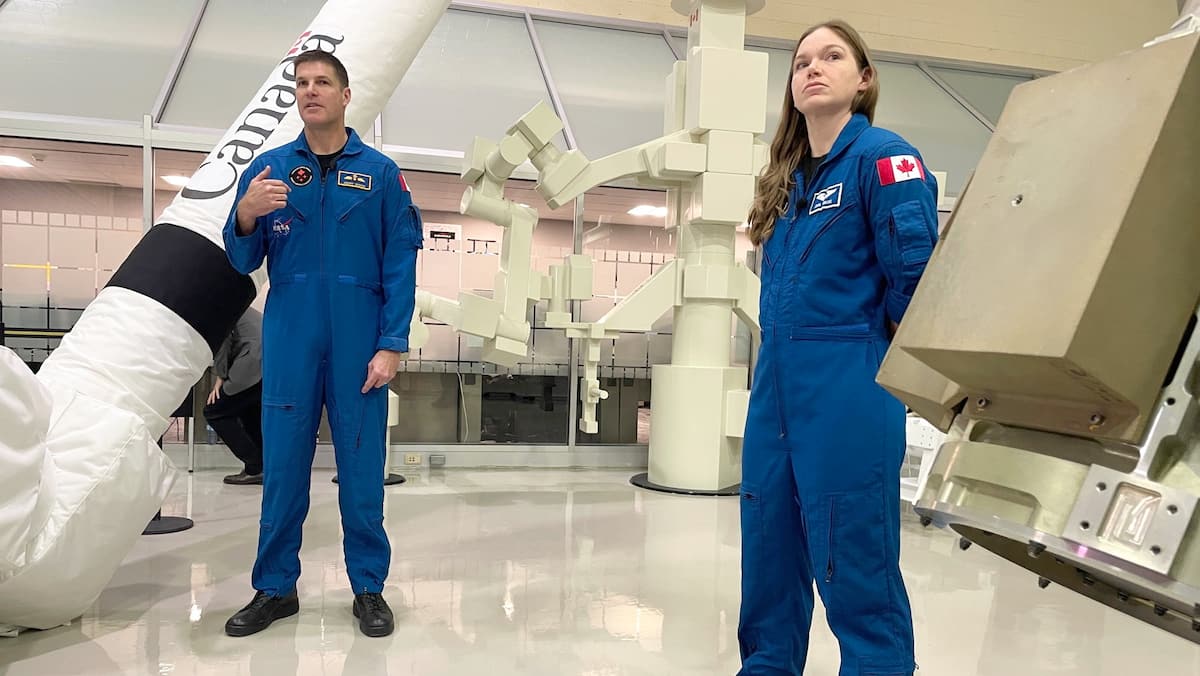There remains a year and a half before Jeremy Hansen’s planned departure for the Moon and the Canadian astronaut must be vigilant if he does not want to see his mission compromised at the last moment by a simple flu which could leave him stuck. ground.
“These are things that can happen and I will respect the decision of the Space Agency,” explained at a press briefing on Monday, the man who has been waiting for his turn for 15 years to fly into space.
“I just hope Jenni likes my menu,” he joked, pointing to his designated replacement, Jenni Gibbons, for the Artemis II mission, the second stage of the Artemis space program, whose objective is to bring humans back to the surface of the Moon.
Canadian astronauts from the Artemis II mission, Jeremy Hansen and Jenny Gibbons.
Photo Mathieu-Robert Sauvé
The first lunar mission since the Apollo program in 1972, the Artemis II mission does not plan a moon landing. The spacecraft will orbit the Moon and return to Earth after 10 days. It should take flight in September 2025.
Highly strategic
In reality, this decision to ground an astronaut who has been training for several years for a mission in space is highly strategic and “relates to the decision of a council of several experts,” explained Annie Martin, who takes care of the health of Canadian astronauts.

The menu planned in the moon rocket includes Canadian smoked salmon.
Photo Mathieu-Robert Sauvé
Even if they are selected based on their exceptional physical condition and family history of cardiac or other issues are taken into account, it can happen that “a simple virus like those that circulate at all times” compromises a mission. .
A cycling accident a few weeks before the big departure could also be a factor leading to the replacement of the Canadian Air Force fighter pilot who was selected for the astronaut program in 2009.
“With a broken arm or leg, it would be very difficult for the astronaut to take his place in the confined space of the Orion rocket,” adds Mme Martin.

Astronauts are taken care of in a medical room at the Canadian Space Agency in Saint-Hubert on February 5, 2024 in the presence of Canadian astronauts Jeremy Hansen and Jenni Gibbons (left). Credit Mathieu-Robert Sauvé
Photo Mathieu-Robert Sauvé
Beware of appendicitis
The Canadian agency’s team of experts, which includes two doctors, works in collaboration with their NASA counterparts who work to reduce the risks. Even if the emphasis is on prevention and maximum precautions are taken to prevent health problems, certain pathologies are almost impossible to predict.

The food that astronauts will eat on the Orion rocket contains very little water.
Photo Mathieu-Robert Sauvé
“A simple appendicitis can cause problems in microgravity,” says Mme Martin.
Telemedicine technologies are also used in recent space missions to remotely monitor the medical conditions of astronauts. “This is knowledge that we can then use on Earth with isolated populations and indigenous communities,” explained Mr. Hansen at the Space Agency’s “lunar base”, a laboratory which could resemble the permanent station on the Moon .
Artemis in summary:
Launched in 2019 by American President Donald Trump, the Artemis program aims to establish a permanent station on the Moon, the first step towards the conquest of the planet Mars. Despite funding issues, the program was continued by his successor, Joe Biden, in February 2021.
The 10-day mission is to be followed by Artemis III, the objective of which will be to place two astronauts on the surface of the Moon in 2026. The astronauts’ stay in space will total 25 days.
The first stage of the Artemis program, consisting of sending an unmanned spacecraft around the Moon, was successfully completed on December 11, 2022 after the spacecraft had traveled more than 2.1 million kilometers.

Maple cookies are featured on the Artemis II mission menu.
Mathieu-Robert Sauvé
